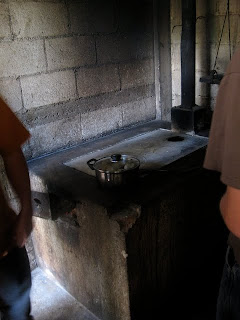
After the trip with Caltech and Art center students we programmed some trips along with other Landivar students and teams, to get more research opportunities, surveys, and general info obtained from what we saw and perceived. During this trip I decided it would be interesting to go with the shoe and honey people to the communities where they are working since that offers the opportunity to obtain info from two perspectives of a rural town, Parramos (a more developed and suburban-ish town) and Aquisiche (a rural town, very similar to Pasajquim). This will be useful for our business plan in locating our target group.
What we wanted to know:
+ Differences in water usage (Between rural and suburban areas)
+ Differences in water knowledge (on disease, where water comes from, if its contaminated, etc)
+ Willingness to pay for a filter or potable water
+ What kind of potable water services they use, how much does it cost?
+ Perception differences (form and function)
+ Water pressure and consistency
+ Main concerns, health vs. saving money
+ Organizations, Entities people trust
+ Branding perception (name, label, info)
+ Having an employee installing and changing replacements vs. DIY
+ Strategic distributors and points of purchase (tienda, ferreteria, mercado, etc)
PARRAMOSParramos is in Chimaltenango, about 30 mins. from Antigua. Surveys where made to Arnulfo and 2 of his sons (they are the family Irene and Giuseppe are working with). When asking Arnulfo about water usage he told me he knows that the water is contaminated and dirty mostly because he can SEE it, the water gets turbid in winter and you can see particles floating around. He also knows it makes you sick drinking it and this is why he buys the 5 gallon salvavidas container (he pays about Q80.00 a month). Water from Parramos is obtained in the same way we've seen in most places (well/municipal container/rotoplas container/chorro de pila) . Water isn't constant it comes to the chorro every 2 days. Arnulfo collects water in old oil drums and he fills his pila so that he can always have water (to water plants, wash clothes, clean patio, etc).
PROTOTYPE PERCEPTION+ Again the chunky one was the winner, but they were all concerned about it being to long, this would represent a difficulty in filling their pilas. They were also concerned about using the filter for "not so important water", Arnulfo suggested a valve with an extra piece where he could attach a water hose to fill his oil drums and water his plants.
+ He said he would be willing to pay up to Q250.00 for the filter and no more than 25 (choca) for the replacements if they were have to be bought every month or less. (Two replacements a month would be a reason not to buy it )
+ Ferreteria is the preferred point of purchase again, I investigated how accessible ferreterias where in the area (there are 10 in Parramos!).
+ The need of a guarantee was brought up again by them, it was interesting that they said that as long as Landivar or something from the city guaranteed it, it was ok.
+ I asked them how would they name it just to see their creativity jaja and they came up with PURIFIC (I guess it's because we have this toilet cleaner called "pato purific" yep...duck purific, and everyone now believes that purific means to purify in English haha!
+ They agreed that it seemed easy enough to change, they said it would be useful to have demonstration on the ferreteria but that once would be enough.
+ They mentioned it would be good to have some sort of indicator that the carbon is saturated, by color or something.
AQUISICHE+ It was kind of difficult to get info in Aquisiché, it a town very similar to Pasajquim. Aquisiché is located really beautiful mountaintop (about 1:30 to go up the mountain in Sophie’s mega terracan!!) amazing view from there, really nice people but also really shy people.
+ To summarize it all I didn't get too much feedback, when I started asking about water they quickly replied that they get water from the mountain and that water from the mountain is clean.
+ They don't associate waterborne diseases with water contamination.
+ They drink directly from the chorro. When they get sick they go to the health stand and get free medicine, so the argument about saving on medicine or salvavidas service was useless to get their attention.
+ They where not really eager to pay for the filter (cause they think they don’t need it)






























